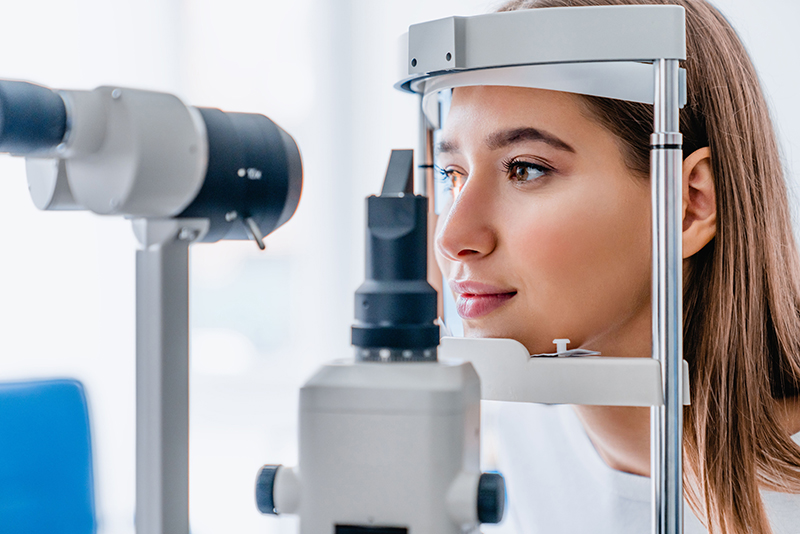Blurry Vision with Contact Lenses? Here’s How to Clear It Up

Wearing contact lenses is meant to offer sharp vision and everyday comfort—without the hassle of glasses. But if you’ve ever found yourself squinting through blurry lenses, you’re not alone. Whether you’re new to contacts or have worn them for years, blurry contact lenses can quickly become a frustrating issue.
The good news? In most cases, it’s an easy fix. In this post, we’ll break down the common causes of blurry contact lenses, how to fix them, and what you can do to keep your vision clear going forward.
What Causes Blurry Contact Lenses?
Blurry contacts can happen for a number of reasons. Here are the most common causes:
1. Dirt, Debris or Buildup
Tiny particles from dust, makeup, or oils on your hands can stick to your contact lenses and blur your vision. Even a tiny smudge can distort your sight, making everything look foggy or out of focus.
Environmental debris such as pollen or pollution can also settle on your lenses throughout the day, especially if you're outdoors often or live in a high-traffic area. If you're wearing makeup, even a small amount of eyeshadow or eyeliner residue can transfer to your lenses and affect your clarity.
Forgetting to wash your hands properly before handling lenses is another common culprit. Even if they look clean, your fingers may still carry oils or bacteria that transfer easily to the lens surface.
These minor issues can add up quickly, especially with extended wear. The good news? They’re also simple to avoid with the right habits and a consistent care routine.
2. Dry Eyes

Dry eyes are a leading cause of blurry contacts. Environmental factors like heaters, air conditioning, windy conditions or extended screen time can all reduce moisture in your eyes, affecting how your lenses sit and feel.
3. Lens Misalignment
If your lens moves out of place—especially if you have astigmatism—it may not sit correctly on your eye. This misalignment can cause blurred or distorted vision until the lens shifts back or is adjusted.
Toric contact lenses for astigmatism require proper orientation to effectively correct the astigmatic axis. To help with this, orientation marks are placed on the lenses to guide correct positioning. These marks are typically small lines or dots that align with the bottom of your eye. Since the design and placement of these marks can vary between brands and products, it's important to follow the specific fitting instructions provided with your lenses.
4. Worn-Out or Damaged Lenses
Overwearing lenses or using them past their replacement schedule can lead to scratches, tears, or deposits. These affect both comfort and clarity.
5. Changes in Prescription
If you’ve noticed a gradual decline in vision, it could be due to a change in your eyesight. Teens and people over 40 are especially prone to prescription changes, often due to natural eye development or age-related conditions.
Astigmatism and presbyopia—which typically progresses after the age of 40—can also develop without you noticing and may lead to blurred vision. It’s important to have regular eye exams and use contact lenses based on the most up-to-date prescription to ensure your vision stays clear and comfortable.
6. Underlying Eye Conditions
Persistent blurriness may point to an eye condition such as dry eye syndrome, corneal damage, or an infection. If in doubt, book an appointment with your optometrist.
How to Fix Blurry Contact Lenses
Now that you know the common causes, here’s what you can do to restore clear vision:
Clean Your Lenses Thoroughly
Always wash and dry your hands before handling lenses. Clean each lens with the appropriate contact lens solution—ideally one that’s compatible with your lens type. Even if your solution is marked “no rub,” it’s still helpful to gently rub the lenses between your fingers to remove any buildup.
Never use water or saliva to clean your lenses—these can introduce harmful bacteria and lead to infections.
Use Lubricating Eye Drops

If dry eyes are the problem, rewetting drops made specifically for contact lens wearers can help restore comfort and clarity. Keeping your eyes hydrated is essential, particularly if you spend long periods in front of a screen.
To prevent digital eye strain, follow the 20-20-20 rule: every 20 minutes, look at something 20 feet away for 20 seconds. It’s a simple habit that makes a big difference.
Check Your Contact Lens Solution

Not all solutions work the same way. Some may be too harsh or not effective for your specific lenses. If you’re using a hydrogen peroxide-based system, be sure to follow all the instructions carefully, including the neutralising step before putting lenses back in.
Always check that your solution is within its expiry date and that you’re using fresh solution each time you store your lenses. Reusing old or contaminated solution can lead to discomfort, reduced clarity, or even eye infections.
If you're using fortnightly or monthly contact lenses, using a protein remover can help keep your lenses clean. However, the necessity may vary depending on the type of lenses and the condition of your eyes, so be sure to consult with your eye doctor before use.
Replace Lenses as Directed
Even if they still feel fine, lenses that are past their replacement schedule may no longer function properly. Over time, they can develop microscopic damage or accumulate deposits, which can cause blurriness or discomfort.
Follow the wear schedule prescribed for your lenses—whether daily, fortnightly, or monthly—and dispose of them on time.
When to See Your Optometrist

If your vision remains blurry even after cleaning your lenses and using eye drops, it may be time to consult your optometrist. You might need an updated prescription, a different type of lens, or treatment for an underlying issue.
Tips to Prevent Blurry Lenses
Preventing blurry contact lenses starts with good habits. Here are some quick reminders:
- Always wash your hands before touching your lenses
- Don’t wear lenses longer than advised
- Keep your lens case clean and replace it regularly
- If you're wearing fortnightly or monthly contact lenses, be sure to store them in fresh solution every day to prevent buildup and contamination
- Take regular breaks from screens
- Use rewetting drops as needed
- Visit your optometrist regularly for check-ups
Final Thoughts
Blurry contact lenses can be inconvenient, but in most cases, they’re easy to fix with a few simple steps. Whether it’s dryness, a dirty lens, or a prescription issue, knowing how to identify and treat the problem will help you keep your vision clear and your eyes healthy.
For more expert advice on contact lens care, eye health, and the best solutions for everyday issues, sign up for our newsletter or explore our latest tips. Clear vision is just a few good habits away.
